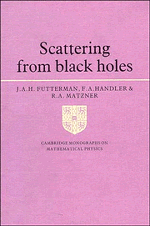Book contents
- Frontmatter
- Contents
- Acknowledgements
- Foreword
- 1 Introduction
- 2 Perturbations of black hole spacetimes
- 3 Integral spin plane waves in black hole spacetimes
- 4 Neutrino plane waves
- 5 Scattering
- 6 Limiting cross sections
- 7 Computation of cross sections
- 8 Absorption, phase shifts and cross sections for gravitational waves
- 9 Conclusion
- Appendix A1 Integrals used to express plane waves in terms of spin-weighted spheroidal functions
- Appendix A2 Addition formulae for spin-weighted spherical angular functions
- Appendix B
- References
- Index
1 - Introduction
Published online by Cambridge University Press: 04 August 2010
- Frontmatter
- Contents
- Acknowledgements
- Foreword
- 1 Introduction
- 2 Perturbations of black hole spacetimes
- 3 Integral spin plane waves in black hole spacetimes
- 4 Neutrino plane waves
- 5 Scattering
- 6 Limiting cross sections
- 7 Computation of cross sections
- 8 Absorption, phase shifts and cross sections for gravitational waves
- 9 Conclusion
- Appendix A1 Integrals used to express plane waves in terms of spin-weighted spheroidal functions
- Appendix A2 Addition formulae for spin-weighted spherical angular functions
- Appendix B
- References
- Index
Summary
Motivation, context and scope
When a physicist thinks of black holes, he may think of one of two substantially different concepts. There is the astrophysical black hole, and there is the black hole of the mathematical model.
Black holes as astronomical objects are the remnants of dead stars, or perhaps one of the remnants of the inhomogeneity spectrum of the early universe. Their detection as astronomical objects has so far only been by indirect means, by observations interpreted via the astrophysicists’ models. The plausible astronomical existence of black holes as X-ray sources, of black holes as the engine of quasi-stellar objects (QSO), of black holes contributing to the mass of the universe as hidden matter, makes them more interesting and more frustrating than one would expect from the mathematical description of a black hole in asymptotically flat space.
The mathematically defined black hole is the picture of simplicity. It depends only on three parameters: mass, angular momentum and charge (Schwarzschild, 1916; Reissner, 1916; Nordstrøm, 1918; Kerr, 1963, Newman et al., 1965. In this work we will largely ignore charged black holes.) It is the ultimate abstraction of a physically gravitating body. One is spared the complexity of describing matter degrees of freedom, and can concentrate on the behavior of the gravitational modes.
This work treats mathematical black holes. We consider scattering of massless waves by black holes embedded in asymptotically flat spacetime. Because of the simplicity of the problem, it is to a large extent explicitly soluble; and where explicit analytic solutions are not possible, a variety of qualitative methods can be applied.
- Type
- Chapter
- Information
- Scattering from Black Holes , pp. 1 - 12Publisher: Cambridge University PressPrint publication year: 1988

